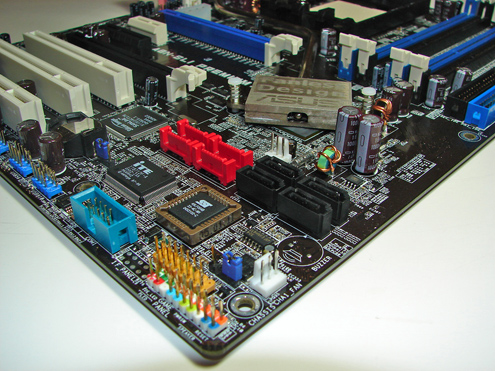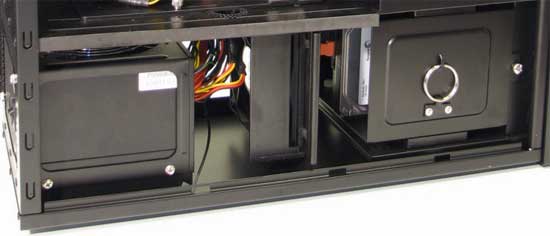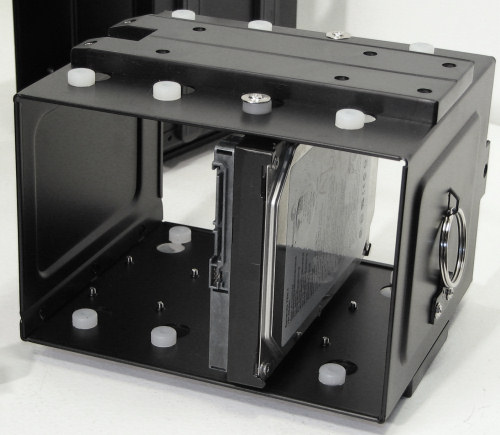A Lesson in User Failure: Investigating the Serial ATA Connector
by Ryan Smith on January 18, 2008 12:00 AM EST- Posted in
- Storage
SATA Anatomy, Failure Anatomy
It’s best to start first with a quick history lesson on the SATA design, as it hasn’t been static through the years. It has gone through some important revisions - some visible and some not – that have shaped the SATA connector in to what we see today. We’d also like to thank Knut Grimsrud, chairman of the SATA International Organization and Intel Fellow in their Technology & Manufacturing group for helping us out with this article and answering some of our questions.
First and foremost, the SATA-IO identified issues early on with the design of the SATA connector, and has revised it several times. This is most obvious in the move from the SATA 1 motherboard connector to the SATA 2 motherboard connector, where the SATA 1 motherboard connector was far more exposed than the SATA 2 connector. This switchover was particularly evident on boards using both native and external SATA controllers, where one would be SATA 2 compliant and the other SATA 1, requiring the different connectors.

The SATA 2 motherboard connector added shrouding around the connector, which significantly improved the durability of the connector as the shrouding prevented cables from easily bending the wafer part of the connector. Unfortunately this kind of shrouding couldn’t be added to SATA devices, because the standard was designed for use in small devices that don’t have clearance to fit a full shroud. This results in the modern half-shroud design for devices, where the top-half of the connector is shrouded by the device but not the bottom half.
The other significant changes in the standard since its inception have been latching and chamfering. Most SATA devices now have recesses in their top side shroud that allow barbs on SATA cables to latch in to in order to provide downward stability since the underside is the unshrouded side. Chamfering has been added to the square edges of the tongue, and while not a visibly dramatic change, we’ve been told this is one of the primary improvements in strengthening the SATA connector.
Yet in spite of these changes we’ve still managed to do something wrong and break the connector on our hard drive. For the reason why, we’ll start with case designs and cable designs.
Part of our problem can be attributed to the amount of space we have to work in with the case involved in this investigation, the Antec P182. The P182, like many other cases, doesn’t leave a lot of space behind the primary hard drive bay. For most cases this is because there are motherboard components and cards in the way, while with the P182 it’s a matter of a 120mm fan being located behind the hard drive bay, which helps pull air through the lower chamber. Either way, with this specific case, we measure that we have about 2” between the rear end of a hard drive and the fan, which is very little space to work in.

We then come to the cable, in this case it was a bog-standard cable that came with one of the products we’ve used over the years. As we mentioned earlier, SATA cables aren’t quite as flexible as PATA cables when it comes to longitudinal bending, and while we can technically bend a cable completely over at any location, this isn’t great because it causes the cable to pull back in to a more relaxed position. From the tip of the connector, the cable we measured needs about 2.5” of space to bend comfortably.

With the amount of clearance we have being less than the amount of space to need to ideally bend the cable, it becomes obvious that this will quickly become tricky. We need to bend the cable at a sharper angle so that it stays well clear of the fan, which means it’s going to be exerting some force on our hard drive, a generally acceptable but not ideal situation.
And then finally there is the layout of the P182’s hard drive bay. The P182 requires the hard drives to be installed in to the cage at an angle, such that they are on their sides with the bottom pointing towards the bottom of the case, which you can see here. Keep in mind the fact that the top hard drive is on the opposite side of the case from where the motherboard is.

In this combination, we have the anatomy of our failure. Our cable is putting force on the SATA data connector towards the bottom side, which as we covered earlier is the weaker direction to go because it’s not shrouded like the top side is. Furthermore we’re using a SATA-1 style cable without a latch, which means we don’t have said latch to reinforce the connection. It turns out that this is enough force to break the SATA data connector on our hard drive, and when the drive cage was being secured one day the connector broke.











62 Comments
View All Comments
iamezza - Sunday, January 20, 2008 - link
I have broken the SATA power connector on my HDD AND on my power supply connection, when trying to install 4 HDDs in the lower bay of a P180.I think both the Data and Power SATA connections are fundamentally flawed and no matter how much they 'update' them there is no way to make them good.
An example of an extremely reliable and robust serial connector is the ubiquitous USB plug. The USB plug is so simple to plug and unplug, yet is robust and it doesn't become accidentally unplugged! Why bother to re-invent the wheel?
LeeKay - Sunday, January 20, 2008 - link
I did the same thing with 3 drives no less 2 320GB Segates and 1 500GB Hitachi on my new system build into my new pc using the lower drive bay because the upper was impeding the 8800Ultra.I fried a 12v ground power trace on one of the drives, chipped off part of the sata connector on another and just snapped off the other one like you did. My problem was that the 500gb was to be my main drive so I tried to use a connector like your blue one with the power and the SATA conector on one plug but the problem was the pc is moved around alot and the connector would lose contact with the gold pins so I took an SATA cable and broke the plastic guard arround the pins. I took my dremel and I cut out the area leading to the pins on the board. I unsoldiered it and then I took the cable and soldered it directly to the board all 6 contacts and then I secured the cable with a metal bracket i cut to size from the back plate drilled small holes in the plate and drive and screwed it in place to hold the cable in place and to stop it flexing. Now it works great.
Ichinisan - Saturday, January 19, 2008 - link
It seems that the major flaw of the proprietary WD "SecureConnect" cable is that it covers the SARA power connector, requiring you to use the 12v connector. Taking away your choice is a problem in some situations. For instance: My legacy-free, super-mini PC chassis expects your SATA drive to use the provided SATA power connector.Snooper - Saturday, January 19, 2008 - link
I've got four HDs in the lower HD cage on my P180. It definitely took a bit of work to get all the cable to lay in place without rubbing against the fan or bending the cables too tightly.But it can be done. Just don't try to force things...
Voldenuit - Saturday, January 19, 2008 - link
I've had the same thing happen to me, but with the SATA power cable instead of the data cable. Fortunately, the drive (A WD 250 GB SE16) had a backup molex power adapter. Wish manufacturers included this as a standard (current WD models have dispensed with them).My opinion is that the SATA connector is fundamentally flawed by design. It is too thin and fragile, and the little right angle hanging off the end is just a disaster waiting to happen.
I wouldn't go back to PATA for the world, but I wouldn't mind seeing a more robust design, even if it means having to switch cables.
mongolhorde - Saturday, January 19, 2008 - link
I had this idea the other day, looking at a CoolerMaster Cosmos 1000 case. It has a section with pull-out drive enclosures for the hard drives, at the bottom, which undoubtedly would require right-angle SATA cables. If people would be willing to pay slightly more, why not make a variant model with an SATA-II compliant backplane? Put both the SATA and SATA power connectors, lined up for the drive cages, behind the drive cage. Then, past the drive, provide the same connector as on the mother board / back of drive for the user to connect up the SATA data cables and power cables.Nothing fancy like in a server, where you maybe have one incoming power lead, just a circuit board with a series of traces to carry the power and data to the drives.
Charge a bit more for that model, or maybe find a way to make it an end user installable accessory...
Help people avoid the situation the article talks about.
Cullinaire - Saturday, January 19, 2008 - link
Mac Pro anyone??Good idea though, I'd really like to see this happen. Even better if the backplane is sold separately.
RaulF - Saturday, January 19, 2008 - link
Well crazy glue just worked for me yesterday guys, i also notice i had damage the SATA cable and that's why the drive was not being recognised. Make sure you inspect the cable conector for the little contact wires. I manage to get my stuff out and will use the handicap HD in an enclusure as my external to take info around to a friends house when i need it.Thanks for the article anand, hopefully manufaturers will beef up the plastic on the connectors from now on.
notposting - Saturday, January 19, 2008 - link
couple issues with this article:First, remove the lower fan from the P180--the PSU will be able to handle exhausting it's own heat and the airflow will be enough to keep the HDs cool enough, that's the point of the separate chambers.
Secondly, the complaint about the HD orientation and the half shroud on the port connector is invalid. Flip the HD. Derr, it's fixed!
pjpizza - Saturday, January 19, 2008 - link
In the fall of 2004, I bought a 74GB WD Raptor. As I had not had any SATA devices before, I just did what I normally do: shove the thing in! To my horrible discovery, I had broken the SATA connection on the WD... :(Luckily, I too had some McGyver tape handy, and I've used it ever since...
Still, makes you wonder why they can't spec the type of plastic used on the the SATA device to keep the connection from breaking... I thought they would be AT LEAST as durable as PATA, I mean, come on? Newer tech should be better then old tech in all aspects.